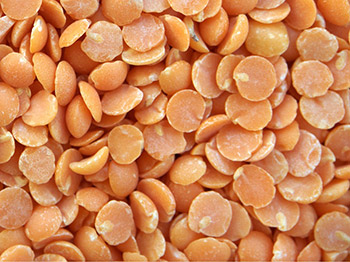
Description & Health Benefits
- Lentils are part of the Fabaceae botanical family which also consists of soy beans, black beans, kidney beans, white beans, pinto beans and peanuts to name a few.
- Lentils are small disk shaped seeds and come in a variety of colors — yellow, orange-red, green, brown, and black.
- Lentils are a nutritional powerhouse. A 1/2 cup serving is an excellent source of folate, fiber, and manganese, and a good source of protein, thiamin, iron, phosphorus, potassium, and copper.
- Folate is required to create DNA and other genetic material. Adequate folate intake reduces the incidence of neural tube defects in pregnant women.
- Fiber aids in a healthy digestive system by preventing constipation. It also helps you to feel full faster which can assist in weight control.
- Manganese assists the body to form bones and connective tissue while also playing a part in calcium absorption and blood sugar regulation.
- Protein helps the body to repair cells and create new ones, which is very important in times of growth and development for children, teens, and pregnant women.
- Thiamin plays a role in muscle contraction and assists the body to convert carbohydrates into energy.
- Iron is required for growth, development, and the creation of red blood cells which are needed to transport oxygen from the lungs to the rest of the body.
- Phosphorus is important in the formation of bones and teeth.
- Potassium supports nerve and muscle communication and helps to maintain normal blood pressure.
- Copper works with iron to form red blood cells and aids in the absorption of iron.
Purchasing, Selecting, Storing, and Preparing
- Purchase lentils prepackaged or in bulk at grocery stores. Lentils may also be available canned. Look for brightly colored lentils that are uniform in size with smooth skins.
- Store lentils in an air tight container that is in a cool, dark, and dry place. Lentils are best used within 1 year of purchase. The older the lentils, the longer they take to cook.
- Prepare lentils by rinsing dry lentils and remove any rocks or pebbles that may be left from processing.
- Presoaking is not required.
- Cook on the stove top, using 1 cup lentils to 3 cups water or stock.
- Lentils will double or triple in size so ensure you are using a large enough pan. Lentil sizes vary.
- Bring lentils and water to a boil, reduce heat to simmer until lentils are tender. Drain water if necessary.
- For whole lentils, approximate cooking time is 15-20 minutes.
- For split lentils, cook for 5-7 minutes.
- Season with salt after cooking otherwise the lentils will becomes tough.
Nutrition Facts
1/2 cup cooked lentils
Calories: 115 | Protein: 8.93 g | Fat: 0.38 g | Carbohydrate: 19.93 g | Fiber: 7.8 g | Calcium: 19 mg | Magnesium: 36 mg | Potassium: 365 mg Vitamin C: 1.5 mg | Folate: 179 µg | Vitamin A: 8 IU
ndb.nal.usda.gov 
Recipes
Request an Appointment
